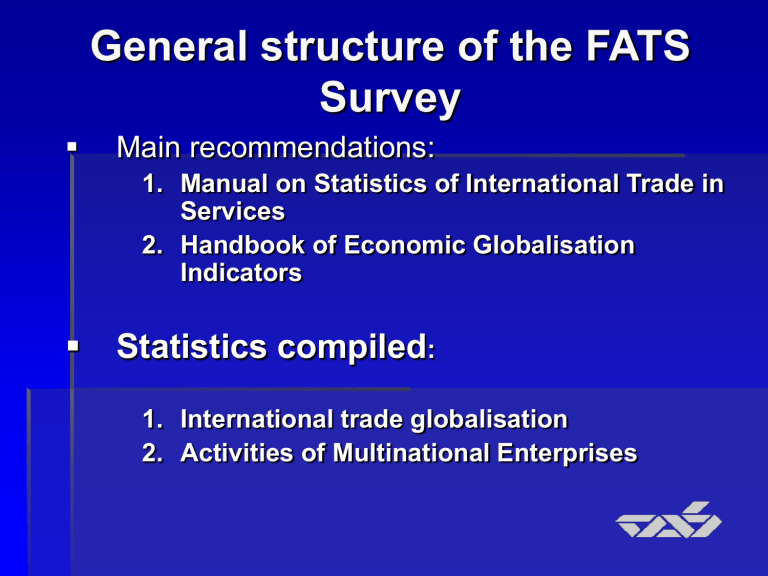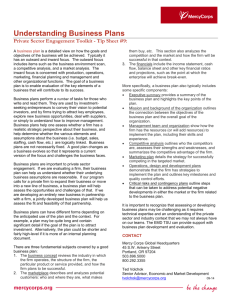General structure of the FATS Survey Main recommendations:

General structure of the FATS
Survey
Main recommendations:
1. Manual on Statistics of International Trade in
Services
2. Handbook of Economic Globalisation
Indicators
Statistics compiled
:
1. International trade globalisation
2. Activities of Multinational Enterprises
General structure of the FATS
Survey
Groups of Multinational companies
1. Inward companies – Domestic companies controlled by foreign parents
2. Outward companies – Domestic companies controlling foreign affiliates
3. Inward-Outward companies – Domestic companies having foreign subsidiaries and also controlled by foreign parents
General structure of the FATS
Survey
Majority ownership criterion
1. Direct Inward/Outward companies
2. Domestic Parent groups
3. Domestic Inward groups
4. Foreign Parent and CAs Groups (only partial)
General structure of the FATS
Survey
All relevant variables classified by:
Countries
Industries – ISIC – Two digits level
Population of the survey
The MBR (Multinational Business
Register)
A register of multinational enterprises operating in Israel was created and the survey was based on the population covered by the register
Population of the survey
The MBR includes :
• Direct Inward/Outward companies
• Domestic companies linked upward or downward to direct Outward companies by a +50% ownership (Domestic Parent
Group)
Population of the survey
• Domestic companies linked downward to direct Inward companies in the same way
(subsidiaries of direct Inward companies)
• Affiliates abroad, directly controlled by domestic Outward companies and foreign parents of domestic Inward companies
It may be a lack of coverage of companies linked to direct
Inward/Outward companies, specially regarding foreign enterprises
Sources of data
The Business Registry Office, where companies must register their names, main occupation and details on owners of shares
CBS Central Business Register
Israel Securities Authority
Tel-Aviv Stock Exchange
Companies engaged in business information and data bases, as D&B, BDI, etc
Press information
FATS Variables – International
Trade
Total exports and imports of goods and services, by Inward and Outward domestic companies, classified by countries and industries.
FATS Variables – International
Trade
International trade of Inward companies, distributed according to trade partners abroad, as follows:
1. Foreign parent group
2. Other affiliates abroad
3. Other (non-affiliates) foreign residents
FATS Variables – International
Trade
International trade of Outward companies, distributed according to trade partners, as follows:
1. CAs abroad
2. Other affiliates abroad
3. Other (non-affiliates) foreign residents
FATS Variables – International
Trade
Sales of goods and services by subsidiaries abroad of domestic
Outward companies, classified by country of sales.
FATS Variables – AMNE
Value added
Output
Employment
All these variables related to Inward and
Outward companies and classified by industries
The sample
The sample was based on :
1.
Industries according to ISIC two digits level
2.
Size of companies according to turnover
Computation of estimates
International Trade
1. Total exports and imports of goods
• Reports from companies in the sample
• Annual customs’ data on a company basis of exports and imports of goods
– BOP adjusted
Computation of estimates
2. Total exports and imports of services
• Reports from companies in the sample
• Exports – Exempted VAT data revenues combined with customs’ data on exports of goods and analysis in a company level for amounts exceeding a defined threshold
• Imports – ITRS data adjusted by preliminary total import figures of the EBOPS sample survey
• End of year 2006: Results of the new EBOPS survey are expected
Computation of estimates
3. Intra-firm trade and trade with unaffiliated foreigners
• Reports from the companies in the sample and grossing-up according to total exports and imports in each industry and size group
4. Sales of goods and services by CAs abroad
• Reports from the companies in the sample
(additional request) and grossing-up by industry and turnover of parents
Main findings
25
20
15
10
5
0
45
40
35
30
Outward and Inward exports and imports from total exports and imports
Outward exports
Inward
Exports
Outward
Imports
Inward
Imports
Main findings
Outward exports and CA sales abroad
7
6
5
4
3
2
1
0
15
14
13
12
11
10
9
8
Outward exports
Sales of subsidiaries abroad
Main findings
Intra-firm trade
50
40
30
20
10
0
100
90
80
70
60
Outward exports
Inward exports
Main problems in data reporting
Consolidated data excluding subsidiaries abroad
Imports by countries
Sales of goods and services by foreign subsidiaries
Recommendations for expansion in future surveys
Complementary data to FDI
If expanding of CAs abroad is heavy financed by credit in host countries, instead of FDI:
FDI may not be well related to total activities of CAs abroad
Additional indicator suggested:
Total assets of CAs abroad =
Total foreign controlled assets by parent domestic companies
Recommendations for expansion in future surveys
This last variable will be closer related to the level of subsidiaries ’ activities abroad independently of the financing scheme adopted by the enterprise
FDI results – Could be misleading in comparing:
Countries – Periods of time – Inward and
Outward FDI
Recommendations for expansion in future surveys
Additional use: Share of foreign controlled assets financed by
“external” as opposed to
“internal’’ funds.
Recommendations for expansion in future surveys
Outsourcing of production abroad
Only Outsourcing of production that is related to activities of
Inward or Outward companies are currently included
Some final remarks
Exclusion of variables that may be estimated by administrative files
Improvement in collection of data on other variables, as UBO, additional activities of subsidiaries abroad, total assets of these subsidiaries, etc.
Thank you
Computation of estimates
Activities of Multinational Enterprises
1. Output
• Reports from companies in the sample
• Income Tax data
• VAT data
• Change in stocks of finished goods and work-in-progress – Industry basis – CBS
Business Department
Computation of estimates
2. Value Added
• Reports from the companies in the sample and grossing-up according to industry and turnover
• Indirect taxes: On an industry basis according to averages from the CBS
Business Department
Computation of estimates
3. Employment
• Reports from companies in the sample
• Data from the National Insurance
Institution


